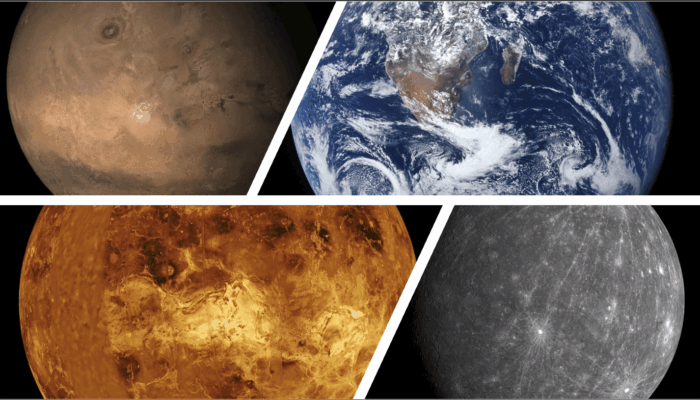
Geological timescales
Unless you regularly work in “deep” time or are very interested in Earth’s very ancient history you might not be too familiar with Earth’s geological timescale. What I am referring to is this:

Earth’s Geological timescale or Chronostratigraphic chart detailing all the time periods in Earth’s history. (credit International commission on stratigraphy (https://stratigraphy.org/chart))
From the very beginning of Earth’s formation ~4.5 billion years ago to today each period is defined and catalogued by events that occurred within them. Many of the periods are named around the place and culture where they were discovered, e.g., the Silurian and Cambrian periods are named after Welsh tribes (see Snowdonia post for more info). The vast majority of the geological boundaries on Earth are defined by life. Either the emergence and/or the extinction of one or more species of creature preserved in the rock record.
But only Earth has widespread and long term life
Only the Earth has life in abundance enough to alter/be recorded on the geological record. Other planets in the solar system might have life but as far as we know they weren’t capable of being widespread enough to be preserved in their respective geological record. If life is used to define boundaries in the geological record then how do we draw boundaries in the geological record of other planets?
Impact events
“Beyond the Earth, geological time is typically divided based on the density of impact craters within well-defined geological units, an approach that relies on the notion that older surfaces accumulated and preserved more and bigger impacts than younger ones.” (Lapôtre et al. 2021)
Much like on Earth the law of superposition is used in lieu of bio- and chrono- stratigraphy. Because the geological records of the other planets are based on impactors their geological timescales are often much simpler. Below I will list the periods for Mercury, Venus, and Mars. Please bear in mind that several of these periods are debated and may be subject to change in the future. I have compiled them to the best of my ability.
Mercury

Geologic timescale of Mercury, images for the periods are in order left to right: Enterprise Rupes, Tolstoj crater, Caloris basin, Hokusai crater, and craters in Caloris basin (image credit Wikipedia)
4.5 – 4 Ga: Pre-Tolstojan
This is the earliest period of Mercury’s history, when it had just formed a crust (Hamano et al., 2013) and was bombarded regularly by impactors from the early solar
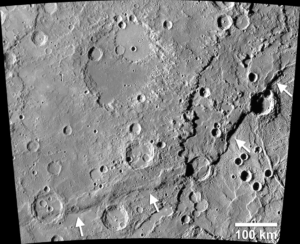
Enterprise Rupes, an ancient cratered terrain with a large fault structure denoted by arrows (taken by MESSENGER spacecraft, credit NASA)
system. The surviving examples of this age are marked by extensive cratering referred to as intercrater plains.
3.9 – 4 Ga: Tolstojan
Named after the Goya formation which consists of the Tostoj impact basin, this period also had extensive plains volcanism which formed smooth plains of fresh lava deposits which due to their younger age contain fewer impacts. Nonetheless this period also has extensive impact cratering (Head et al., 2007).
3.9 – 3.5 Ga: Calorian
Named after the Caloris Planitia which is a large impact crater in Mercury’s Northern Hemisphere which soon after filled with lava and formed a smooth plain inside the crater. This period is also marked by wrinkle ridges and lobate scarps which are believed to have formed from the thermal contraction of Mercury as it cooled (Loveless & Klimczak 2025).
The end of the Calorian period and beginning of the Mansurian period is debated (Denevi et al., 2018). The stratigraphy of Mercury can be tied quite closely with that of Earth’s Moon (Head et al., 2007), which helped to form the initial scale (and the one we show here), although, more contemporary scales place the end of the Calorian at between 1.8 and 1 Ga and also suggest the Kuiperian is also shorter.
3.5 – 1 Ga: Mansurian
Impactor frequency and geological activity wane and Mercury enters a period of geologic quiescence. This period does still experience some impact events which tend to produce rayed impact craters, that is craters that have bright reflective ejecta (Allen 1977).
1 – 0 Ga Kuiperian
Mercury has changed little over the past billion years, with impactor frequency now quite low and geologic activity also very low (Denevi et al., 2018). The only change that defines the Mansurian and Kuiperian periods is Kuiperian craters do not generate rayed ejecta like their older counterparts.

Modified from Denevi et al., (2018) beginnings of each geological period on Mercury in billion years (Ga) (except for the Pre-Tolstojan) showing their differences depending on methodology. *For simplicity we chose 3.25 Ga for the mercury geological scale above.
Venus

Geologic timescale of Venus, images for the periods are in order left to right: Artists interpretation of Early Venus with surface water, and its present day view,Tessera near Maxwell Montes, false colour of Gula mons, dark parabola around Adivar crater (image credit NASA, Wikipedia, Ganey et al., 2023).
Pre-Fortunian

Maxwell Montes on Venus with Tessera terrain visible as white streaks to the right of the image (By NASA/JPL).
Very little is known of Venus from this period due to its age and the geological activity of Venus that has occurred since then. Remnants may exist, however they are yet to be observed due to the difficulty of exploring Venus’ surface.
Fortunian
During this period Venus was intensely deformed by compressive, then extensional tectonic motion (Basilevsky & Head 1998). The famous Tessera of Venus mark this period (Ivanov & Head 2011).
Guineverian
This period marks the almost global volcanic resurfacing that occurred on Venus around 1 billion years ago. The majority of Venusian coronae also formed during this period (Ivanov & Head 2011).
Atlian/Aurelian
Unlike Mercury and Mars, Venus is still very much geologically active. Contemporary volcanism still occurs on Venus today. This period is marked by prominent rift zones, and lava plains from prominent shield volcanoes which are unmodified by compressional deformation like wrinkle ridges (Ivanov & Head 2011).
Mars

Geologic timescale of Mars, images for the periods are in order left to right: A triple crater in Noachis terra, Tinto Vallis in Hesperia Planum, Reull Vallis in Amazonis Planitia (image credit Wikipedia, DLR, NASA)
4.5 – 3.7 Ga: Noachian (sometimes divided further into pre-Noachian 4.5 – 4.1 Ga)
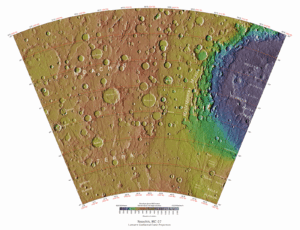
Noachis Quadrangle in the Martian Southern Highlands (By USGS (United States Geological Survey)).
Named after the Noachis terra region this period is defined by the formation of the first crust on Mars and its near constant bombardment by impactors. Noachis terra is a surviving example of an ancient cratered terrain in the Southern Highlands of Mars. One particularly large impact that marks the Eastern edge of Noachis terra is the Hellas basin which retains its low elevation to today ~8 km below the Martian Geoid. Whether also by giant impact, or some internal mechanism like extensive volcanism or mantle convection (Watters et al., 2007) the Martian Hemispheric dichotomy also formed at this time. The Northern lowlands of Mars are younger, smoother, and lower in elevation than the Southern Highlands. It is likely the volcanoes of Tharsis region were also active during this period and had began to form the huge volcano of Olympus mons already during this early time (Phillips et al., 2001).
3.7 – 3.0 Ga: Hesperian
Named after Hesperia planum, a region with extensive and late Hesperian volcanic flows, this period is marked by extensive fluvial incision across the Northern Highlands (Hynek et al., 2010). While we know the Noachian also had fluvial incision, this period has long winding rivers still visible on Mars today.
3.0 – 0 Ga: Amazonian
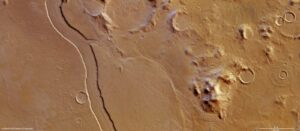
Reull Vallis. (Credit: ESA/DLR/FU Berlin
Named after Amazonis Planitia in the Southern lowlands to the west of Olympus Mons, this period somewhat marks the gradual reduction in fluvial, impact, tectonic, and volcanic activity on Mars. By 3 Ga Mars may have been struggling to retain an atmospere and ocean (Schmidt et al., 2022). Most of the water on the surface either was lost to space or adsorbed into the surface (Kite 2019).
References

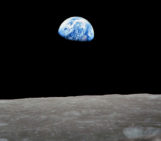

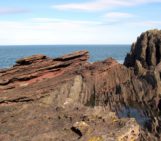

Richard Bready
A very welcome expansion of perspective in four dimensions, plus a handsome chart. Thank you.